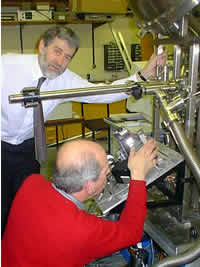|
|
Reflection Anisotropy SpectroscopyResearch in surface science began in the 1960's with the
development of ultra high vacuum (UHV) techniques and enormous progress has
been made in the understanding of surfaces and surface processes by making
use of such techniques. However in my opinion it is timely for surface
studies to move out of UHV and become concerned with real surfaces and in
particular with the important surface processes that involve biological
systems ranging from molecules to cells. The study of biological systems requires techniques that
can provide information on a liquid environment. My group are playing a
leading role in developing the promising optical technique of RAS which, when
combined with local expertise in electrochemistry, (C.I. Smith and R.J.
Nichols), scanning probe microscopy (D.S. Martin) and synchrotron based
surface x-ray diffraction techniques (C. Lucas) has great potential for the
study of molecular assembly at metal/liquid interfaces. RAS instruments are not commercially available and two
instruments of the traditional Aspnes design have been completed in Liverpool
with support from the EU ESPRIT programme (EPIOPTICS, 1989-92, EASI:
1992-95). In 1998 the Paul instrument fund of the Royal Society made an award
to support the construction of a next generation instrument of novel design.
This Rapid RAS instrument has recently been completed. The EPSRC has
awarded grants to develop RAS as a probe of metal surfaces, to support the
first application of RAS to the study of metal-liquid interfaces, to
investigate DNA adsorbed at metal/liquid interfaces and to study interactions
between nucleic acids in relation to biomedical implants. The BBSRC has
awarded a grant to use RAS to monitor conformational change in proteins. De
Beers are supporting research on the application of RAS to diamond surfaces
and the programme is also supported by a Marie Curie Fellowship funded by the
EU. Scientific highlights of the programme in include; 1 The first application of RAS to a metal/liquid
interface; Au(110)/electrolyte. 2 The demonstration that RAS is sensitive to the
orientation of surface dimers. 3 The demonstration that RAS can reveal the three
dimensional orientation of molecules adsorbed at metal / liquid interfaces. 4 Demonstrating that RAS can distinguish between single
and double stranded DNA adsorbed on Au and Diamond surfaces and has potential
as a fast, cheap and accurate method of genetic screening. 5 The monitoring of conformational change in proteins
resulting from electron transfer in real time. |
